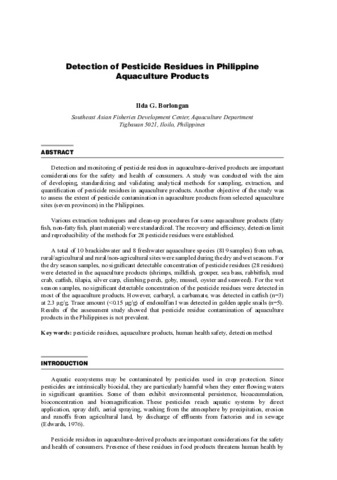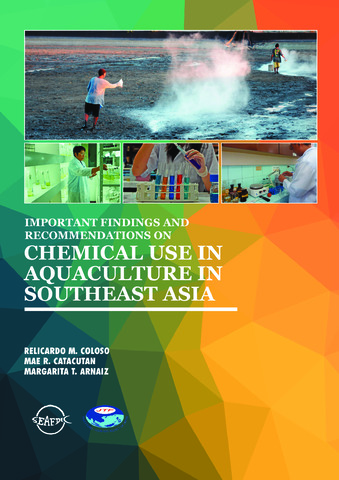Detection of pesticide residues in Philippine aquaculture products
- Global styles
- MLA
- Vancouver
- Elsevier - Harvard
- APA
- Help
Share
Abstract
Detection and monitoring of pesticide residues in aquaculture-derived products are important considerations for the safety and health of consumers. A study was conducted with the aim of developing, standardizing and validating analytical methods for sampling, extraction, and quantification of pesticide residues in aquaculture products. Another objective of the study was to assess the extent of pesticide contamination in aquaculture products from selected aquaculture sites (seven provinces) in the Philippines.
Various extraction techniques and clean-up procedures for some aquaculture products (fatty fish, non-fatty fish, plant material) were standardized. The recovery and efficiency, detection limit and reproducibility of the methods for 28 pesticide residues were established.
A total of 10 brackishwater and 8 freshwater aquaculture species (819 samples) from urban, rural/agricultural and rural/non-agricultural sites were sampled during the dry and wet seasons. For the dry season samples, no significant detectable concentration of pesticide residues (28 residues) were detected in the aquaculture products (shrimps, milkfish, grouper, sea bass, rabbitfish, mud crab, catfish, tilapia, silver carp, climbing perch, goby, mussel, oyster and seaweed). For the wet season samples, no significant detectable concentration of the pesticide residues were detected in most of the aquaculture products. However, carbaryl, a carbamate, was detected in catfish (n=3) at 2.3 μg/g. Trace amount (<0.15 μg/g) of endosulfan I was detected in golden apple snails (n=5). Results of the assessment study showed that pesticide residue contamination of aquaculture products in the Philippines is not prevalent.
Suggested Citation
Borlongan, I. G. (2005). Detection of pesticide residues in Philippine aquaculture products. In K. Nagasawa (Ed.), Recent Advances in Diagnosis and Prevention of Fish and Shrimp Diseases in Southeast Asia (pp. 329–335). Tigbauan, Iloilo, Philippines: Aquaculture Department, Southeast Asian Fisheries Development Center.
Type
Book chapterISBN
9718511732
Related items
Showing items related by title, author, creator and subject.
-
Important findings and recommendations on chemical use in aquaculture in Southeast Asia
Coloso, Relicardo M.; Catacutan, Mae R.; Arnaiz, Margarita T. (Aquaculture Department, Southeast Asian Fisheries Development Center, 2015)Under the program of Fisheries Consultative Group of the ASEAN (Association of South-East Asian Nations) - SEAFDEC (Southeast Asian Fisheries Development Center) Strategic Partnership Mechanism, a research project entitled ... -
Survey of antibiotic and pesticide residues in aquaculture products in the Philippines
Catacutan, Mae R.; Coloso, Relicardo M.; Arnaiz, Margarita T. (Aquaculture Department, Southeast Asian Fisheries Development Center, 2015)A survey in the Philippines in the early and mid-1990s (Lacierda et al.,2008) revealed that more than 100 chemicals and biological products are used in aquaculture production starting from pond preparation until harvest ... -
Seasonal growth, carrageenan properties, and resistance to disease and epiphytic pests between Kappaphycus alvarezii (Rhodophyta) var. tambalang (brown) tissue-cultured and farm-sourced seaweeds
Faisan, Jr., Joseph ; Samson, Edcel Jed D.; Sollesta-Pitogo, Hananiah; Dayrit, Rheniel; Balinas, Vicente T.; de la Peña, Leobert D. (Springer, 2024-01-08)
Growth performance (specific growth rate [SGR] and biomass yield), carrageenan properties (yield, viscosity, and gel strength), and disease and pest incidence were compared between Kappaphycus alvarezii var. tambalang ...55 Total citations5 Recent citationsn/a Field Citation Ration/a Relative Citation Ratio
; Samson, Edcel Jed D.; Sollesta-Pitogo, Hananiah; Dayrit, Rheniel; Balinas, Vicente T.; de la Peña, Leobert D. (Springer, 2024-01-08)
Growth performance (specific growth rate [SGR] and biomass yield), carrageenan properties (yield, viscosity, and gel strength), and disease and pest incidence were compared between Kappaphycus alvarezii var. tambalang ...55 Total citations5 Recent citationsn/a Field Citation Ration/a Relative Citation Ratio


 AQD Access
AQD Access



